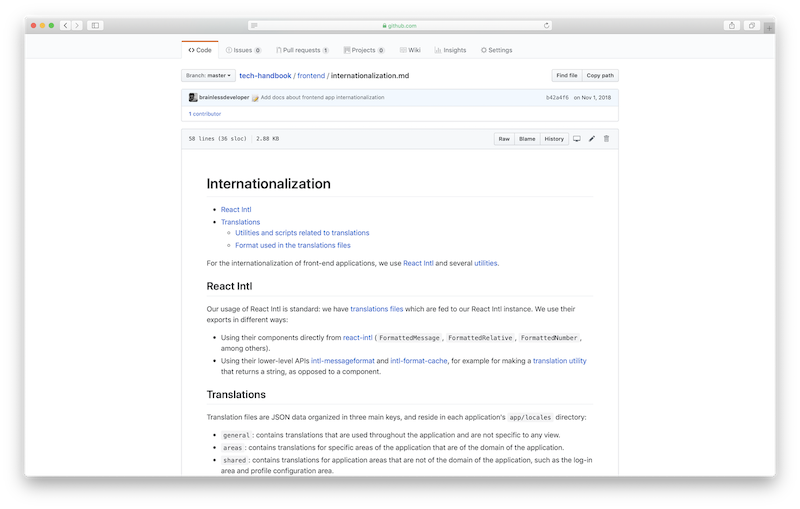 Our documentation setup (photo by Michael D Beckwith, flickr)
Our documentation setup (photo by Michael D Beckwith, flickr)
Intro
Ink is better than the best memory. 🎓
This is the subtitle of our tech documentation!
If you haven’t thought about documentation in a small team, with a growing team you eventually realise how important documentation is. Even for one person alone, it takes a lot of cognitive load to remember all the knowledge when it is not written down. In a team, documentation is even more important and acts as a communication tool and ensures that everyone has the same understanding of certain topics. Documentation also helps a lot in conducting non-automated regular tasks that occur in a low frequency.
In this article, we want to share how we approach documentation at store2be. Documentation happens on different levels:
- Company-wide documentation
- Tech documentation
- Infrastructure as code
- App-specific documentation
- Code documentation
Everything that is of importance for all departments needs to go into our company-wide documentation. For example, if something technical is important for the product team as well, we will put it in the company-wide documentation.
The tech documentation is for all the technical things that are only relevant for the engineering and the devops team. In this part of the documentation, there is also frontend and backend related documentation that is shared across all our apps, so we don’t have to repeat it in these repositories.
Our tech documentation is a Git repository with markdown files. This has the advantage that we can write it offline and use our favourite tools to edit and search through it. Also, this allows everyone to always have a local copy of the whole documentation present.
Infrastructure as code happens, when you use tools to describe your infrastructure in a declarative way and you don’t manage your infrastructure manually. Some tools that we use in that context are Terraform and Kubernetes.
If something specific to an app needs to be documented, we will mostly put it into the README.md of the respective Git repository. Examples here are e.g. app specific scripts/commands and what they are there for.
We won’t go into details about code documentation, because this is something a whole blog post on its own can talk about, but we want to mention it for completeness here anyway. It goes without saying that we try to document our code as best as possible: we do sometimes pull code documentation out into the tech documentation when the concept behind the code is important enough.
Tech Documentation
 The Tech Handbook
The Tech Handbook
The main topic of this blog post is our tech documentation. In this part of the documentation, we collect most of the knowledge of the engineering team and this is what helps us scale the engineering team. We call it: The Tech Handbook.
Looking back at 2017, we had nearly no tech documentation at all. We were still just a team of three and hadn’t thought too much about documentation at that point. In hindsight, this is super bad and something we will avoid in the future, because now we know how valuable proper documentation is.
By the end of 2017, we had three people joining in the beginning of 2018 and we knew, we had to share a lot of knowledge with them. That’s when we began the groundwork of our Tech Handbook.
In the beginning, we focused on the areas that we needed to share with the new developers from day one, e.g. processes and tools. The infrastructure sections followed quickly, as infrastructure work is mostly done once and then looked at again a lot later at which point you have probably forgotten a lot of it.
Since then we continuously add new things along the way, and documentation has become part of our tech culture.
Keeping documentation up to date is a whole different challenge. At store2be, it’s a collective effort (we apply the Boy Scout Rule to our documentation as well as our code). As soon as we discuss process changes for example, we assign someone with the task of updating the relevant part in the tech documentation via our project management tool. This helps us in organizing documentation changes together with our normal development workflow. Thankfully, we use Git and GitHub for our Tech Handbook, everyone else in the team can review the documentation changes and comment on them. So in the end, we’re all on the same page again.
We divided our Tech Handbook into the following areas:
- General
- Processes and tools
- Infrastructure
- Backend
- Frontend
- Post mortems
These sections are all pretty self-explanatory. The last section, post mortems, is the newest section that we added in autumn 2018. We realized that most of the time the same people worked on finding and fixing critical issues in our systems without much transparency to the rest of the team. We occasionally had small presentations of what caused the problem, but if a similar problem occurred again, the person working on it had to remember it. This approach doesn’t scale well, and even if the same person worked on a similar problem again, this person might have forgotten parts of the previous solution.
With the post mortems in our Tech Handbook, we can now share the steps on how we were able to debug an issue easily, and because everyone reviews it, everyone gets a feeling for possible issues and can account for it while coding.
Conclusion
All in all, we are very happy with our choice of building up our Tech Handbook and can really recommend it to teams that need to maintain a working knowledge of complex systems (and what engineering team doesn’t?). It protects us from losing knowledge, lets us onboard new people way easier and faster, and in general lets us sleep easier knowing that the things we learn and do end up in the team’s collective knowledge, so we can continue growing well into the future.
Also published on dev.to and medium.com.